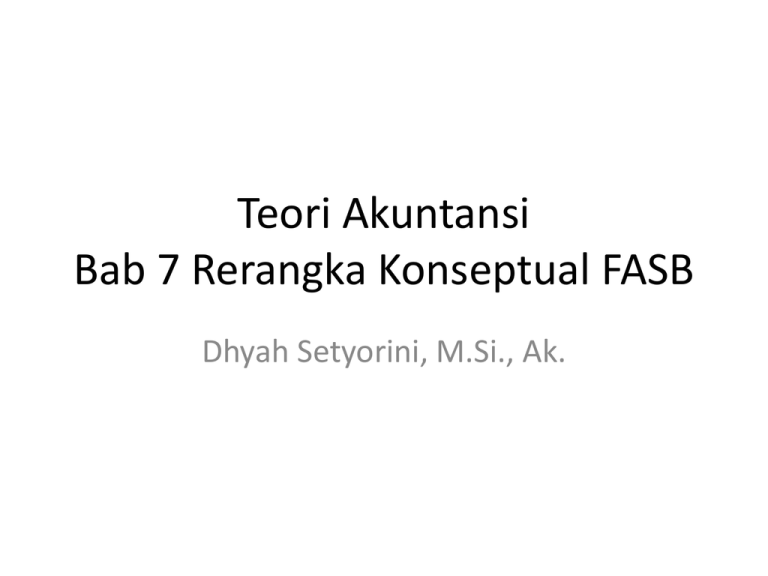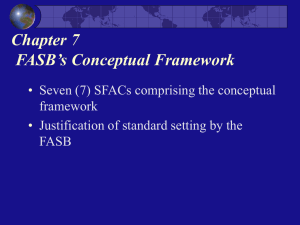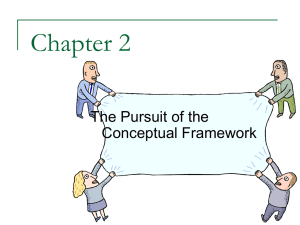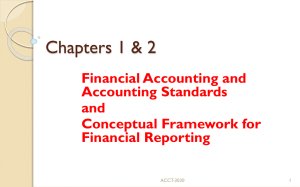Teori Akuntansi Bab 7 Rerangka Konseptual FASB Dhyah Setyorini, M.Si., Ak.
advertisement

Teori Akuntansi Bab 7 Rerangka Konseptual FASB Dhyah Setyorini, M.Si., Ak. FASB’s Conceptual Framework • Six (6) SFACs comprising the conceptual framework • Justification of standard setting by the FASB Conceptual Framework Discussion Memorandum • Brought up two new basic issues 1. Three views of financial accounting and financial statements 2. An outline of various approaches to capital maintenance • Accompanied by another document pertaining to conclusions of Trueblood Report Conceptual Framework Consists of 6 SFACs (Statement of Financial Accounting Concept) 1 Objectives of Financial Reporting by Business Enterprises 1978 2 Qualitative Characteristics of Accounting Information 1980 3 Elements of Financial Statements of Business Enterprises 1980 4 Objectives of Financial Reporting by Nonbusiness Organizations 1980 5 Recognition and Measurement in Financial Statements 1984 6 Elements of Financial Statements 1985 SFAC 1: Objectives of Financial Reporting by Business Enterprises • A cautious invocation of the Trueblood Committee objectives • Financial statements – User orientation – Users assumed to be knowledgeable about financial information and reporting – Must be general purpose in nature, aimed at a common core of information needs SFAC 2: Qualitative Characteristics of Accounting Information • Specific qualitative characteristics addressed can be classified as under the heading of ”decision usefulness” • The characteristics are defined within two constraints – Benefits > Costs – Materiality Decision Makers Understandability Decision Usefulness Relevance Comparability Reliability Decision Makers Benefits > Costs Understandability Decision Usefulness Relevance Comparability Materiality Reliability Benefits > Costs Relevance Predictive Value Feedback Value Materiality Timeliness Decision Makers Benefits > Costs Understandability Decision Usefulness Relevance Comparability Materiality Reliability Benefits > Costs Reliability Verifiability Neutrality Materiality Representational Faithfulness Decision Makers Benefits > Costs Understandability Decision Usefulness Relevance Comparability Materiality Reliability SFAC 3: Elements of Financial Statements of Business Enterprises • Defines 10 elements of financial statements • Later amended in SFAC 6 • Does not include – Type of capital maintenance concept to use – Matters of recognition (realization) • Reversal of terminology – SFAC 1 used the term earnings – Official term: income SFAC 4: Objectives of Financial Reporting by Nonbusiness Organizations • Nonbusiness organizations – Receipts of resources without expectation of repayment or economic benefits – Operating purposes that are primarily not to provide goods or services at a profit – Absence of defined ownership... • Do not have a single indicator of entity performance comparable to income measurement SFAC 5: Recognition and Measurement in Financial Statements • Did not meet expectations • Stated that changed should be gradual and evolutionary • Display of owners’ equity – Recast performance into earnings and comprehensive income – Inability to come to grips with the measurement problem SFAC 5: Recognition and Measurement in Financial Statements • Recognition criteria: When should an asset, liability, expense, revenue, gain, or loss be recorded in the accounts? – – – – Definition, is an element of financial statements Measurability Relevance Reliability • Greater detail needed for recognition criteria SFAC 6: Elements of Financial Statements • A replacement of SFAC 3, not a revision • Definitions are virtually identical to SFAC except they are extended to nonbusiness organizations • Qualitative characteristics of SFAC 2 are extended to nonbusiness organizations • Added nothing to the conceptual framework from business enterprise perspective SFAC 6: Elements of Financial Statements (10) 1. 2. 3. 4. Assets Liabilities Equity Investments by Owners 5. Distributions to Owners 6. Comprehensive Income 7. Revenues 8. Expenses 9. Gains 10. Losses Conceptual Framework Consists of 6 SFACs (Statement of Financial Accounting Concept) 1 Objectives of Financial Reporting by Business Enterprises 1978 2 Qualitative Characteristics of Accounting Information 1980 3 Elements of Financial Statements of Business Enterprises 1980 4 Objectives of Financial Reporting by Nonbusiness Organizations 1980 5 Recognition and Measurement in Financial Statements 1984 6 Elements of Financial Statements 1985 Standard setting by the FASB? Justification • Codification approach, the process is key – Seen as rational – Good reasons for the choice of accounting standards, although they may not be the ”best” possible standards – Differs from the foundational standard setting used with ARSs 1 and 3 • Jurisprudential approach Referensi • • • • • • • • Suwardjono. 2006. Teori Akuntansi: Perekayasaan Pelaporan Keuangan. Edisi Ketiga. Yogyakarta: BPFE (S) Anis Chariri dan Imam Ghozali (2001). Teori Akuntansi. Edisi Pertama. Semarang: Badan Penerbit Universitas Diponegoro (CG). Financial Accounting Standards Board (1996). Statements of Financial Accounting Concepts. Connecticut: John Willey and Sons (SFAS). Sofyan Syafri Harahap (2001). Teori Akuntansi. Jakarta: PT RajaGrafindo Persada (SS). Wolk, Harry I., Michael G. Tearney, James L. Dodd (2001). Accounting Theory: A Conceptual and Institutional Approach. 5th ed. US: South-Western College Publishing (WTD). Standar Akuntansi Keuangan (2007). Ikatan Akuntan Indonesia. Jakarta: Salemba Empat. (SAK) Standar Profesional Akuntan Publik (2001). Ikatan Akuntan Indonesia. Jakarta: Salemba Empat. (SPAP) Statements of Auditing Standards (SAS)




